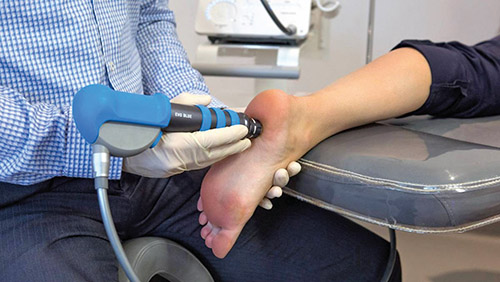


Heel pain can have many causes and one of the most common causes of heel pain is plantar fasciitis.
If you have ever experienced plantar fasciitis, you know how debilitating it can be. If you are lucky enough to have never had it but are curious, try stepping on a Lego® barefoot. In our practice we see athletes as well as those who live a more sedentary lifestyle come in with this condition. As with any medical condition, we want to address the two main questions patients usually have: “What is it?” and “How do we fix it?”
The plantar fascia is a thick band of tissue that runs across the bottom of the foot and connects your heel bone to your toes. The fascia acts like a bowstring and stretches to help absorb shock with each step. With repeated stretching -if the fascia is too tight or the force is too great-, a cascade of inflammation and irritation ensues. Pain is usually in the center of the heel and a classic symptom is pain on the first step in the morning or after prolonged sitting. Diagnosing plantar fasciitis is done through physical exam and clinical history. X-rays are not necessary for the diagnosis but can help reveal any underlying bony abnormalities such as a large spur.
Thanks to the internet and Google, most patients already come in with some underlying understanding of the disease process. However, other causes of heel pain exist such as tarsal tunnel syndrome, calcaneal stress fractures and Baxter’s nerve entrapment. A visit to a foot and ankle specialist can help avoid a wrong self-diagnosis obtained from WebMD.
Whether you are an athlete, a weekend warrior or a couch potato, the primary goal is to get you back to pain-free activity as quickly and safely as possible. Fortunately, the great majority of plantar fasciitis cases resolve with conservative care in a few months time. The first step is addressing the inflammatory process either with oral antiinflammatories, or in particularly severe cases, a local corticosteroid injection. Next, it is important to address the mechanical factors contributing to the pain––otherwise once the medication is stopped or the injection wears off, the pain is likely to return. This is done through plantar fascial stretching, like rolling a tennis ball under the bottom of the foot, or wearing a night splint to keep the fascia and calf muscle stretched and other physical therapy modalities. Custom foot orthotics can help address any mechanical issues contributing to the pain such as a collapsing arch.
For those few unrelenting cases the doctors at CMD are able to offer shockwave therapy, as well as the minimally invasive Tenex procedure, when conservatie treatments have failed. Both therapies are main-stays in the sports medicine world. Extracorporeal shockwave therapy (ESWT) utilizes ultrasound shockwaves targeted at the area to break up scar-tissue and elicit an acute inflammatory response to promote increased blood flow and healing potential. It is done over four to five 10-minute treatments. The Tenex procedure uses a small needle under ultrasound imaging to view and selectively remove damaged tissue. Removing the damaged tissue allows the fascia to heal properly and relieve pain. It is minimally invasive, requires no stitches and allows immediate weight-bearing with a small bandage.
Getting patients back on their feet pain free-is our priority at The Center for Musculoskeletal Disorders. The Foot and Ankle Division at CMDhas the latest in diagnostic testing, minimally invasive procedures, experience and expertise to help you put your best foot forward.
A Brooklyn native, Dr. David Mandil received his Doctor of Podiatric Medicine degree from the New York College of Podiatric Medicine and completed his residency at Lenox Hill Hospital, a leader in orthopedic surgery and sports medicine. Dr. Mandil treats all manner of foot and ankle pathologies, but he has a passion for using minimally invasive techniques, as well as arthroscopy, to avoid large incisions and speed up recovery times. Dr. Mandil is board certified by the American Board of Podiatric Medicine and an Associate of the American College of Foot and Ankle Surgeons.










